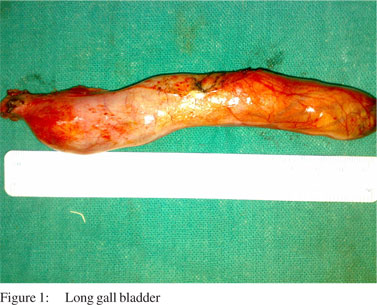|
|
|
|
 |
 |
| |
 |
|
|
Case Report |
|
|
|
|
|
Keywords :
|
|
|
Mohit Kumar Joshi, Maninder Singh Jaura, Kartikeya Rajdev, Shaan E Alam
Department of Surgery,
University College of Medical Sciences and GTB Hospital
New Delhi - 110095, India
Corresponding Author:
Dr.Mohit Kumar Joshi
Email : drmohitjoshi@gmail.com
DOI:
http://dx.doi.org/10.7869/tg.2012.19
48uep6bbphidvals|504 48uep6bbph|2000F98CTab_Articles|Fulltext An anatomically normal and healthy gallbladder in humans measures 7-10 cm in size. Although some variation in its size is common but massive congenital enlargement is rare. We report a congenitally large gallbladder measuring 17.5×3 cm, the second largest gall bladder reported so far.
Case report
A 33-year-old lady presented with history of episodic colicky pain in right upper abdomen of 1 year duration. There was no history of jaundice or fever. Clinical examination was unremarkable except for mild tenderness in right upper abdomen on deep palpation. Laboratory investigations including liver function tests were within normal limits. Ultrasonography of abdomen revealed a gallbladder (GB) filled with multiple calculi. The size of GB was not mentioned, common bile duct (CBD)and intra-hepatic biliary radicals were reported normal. A diagnosis of biliary colic secondary to cholelithiasis was made and the patient was planned for open cholecystectomy. During cholecystectomy, minimal pericholecystic adhesions and a GB measuring 17.5×3 cm with multiple stones was found (Figure 1). No stone was palpable at GB neck or cystic duct. CBD was not dilated and no stones were palpable in it. There was no mucocele or pyocele. The patient made an uneventful recovery. In the absence of any evidence of biliary tract obstruction, this massive enlargement of GB was considered congenital.
 Discussion
Normal size of GB in humans is 7-10 cm with a volume of 30-50 cc.[1,2] Some variation in the size of GB is common but its massive congenital enlargement is rare. The gall bladder may enlarge in some pathological conditions like mucocele, empyema, carcinoma, acromegaly[3] (as a part of generalised visceromegaly), aneuploidy[4] and GB volvulus.[5] Congenitally large GB is extremely rare and only one such case has been reported so far.[6] We encountered a huge GB, in all probability a congenital one and hence, considered it worth reporting. During laparoscopic cholecystectomy, such enlarged GB may be a cause for potential misidentification of structures thereby predisposing to increased incidence of iatrogenic injuries. An enlarged GB may be mistaken for hepatic flexure of colon or duodenum making the task of the surgeon arduous. One may be compelled to place the sub-hepatic port more laterally or at times may have to place additional ports for handling and adequate traction of such large GB. During its dissection from the liver bed, the increased size and consequently more handling may predispose adjacent structures like duodenum, colon, and stomach to iatrogenic injuries. Identification of a large sized gall bladder pre-operatively may help the surgeon in making appropriate changes in the operative steps for cholecystectomy.
References
Discussion
Normal size of GB in humans is 7-10 cm with a volume of 30-50 cc.[1,2] Some variation in the size of GB is common but its massive congenital enlargement is rare. The gall bladder may enlarge in some pathological conditions like mucocele, empyema, carcinoma, acromegaly[3] (as a part of generalised visceromegaly), aneuploidy[4] and GB volvulus.[5] Congenitally large GB is extremely rare and only one such case has been reported so far.[6] We encountered a huge GB, in all probability a congenital one and hence, considered it worth reporting. During laparoscopic cholecystectomy, such enlarged GB may be a cause for potential misidentification of structures thereby predisposing to increased incidence of iatrogenic injuries. An enlarged GB may be mistaken for hepatic flexure of colon or duodenum making the task of the surgeon arduous. One may be compelled to place the sub-hepatic port more laterally or at times may have to place additional ports for handling and adequate traction of such large GB. During its dissection from the liver bed, the increased size and consequently more handling may predispose adjacent structures like duodenum, colon, and stomach to iatrogenic injuries. Identification of a large sized gall bladder pre-operatively may help the surgeon in making appropriate changes in the operative steps for cholecystectomy.
References
- Susan Standring, editor. Grays anatomy- the anatomical basis of clinical practice. 40th ed. Spain: Churchill Livingstone; 2008.
- Snell RS, editor. Clinical anatomy by regions. 8th ed. Elsevier; 2008.
- Cohen GA, Smoak WM, Goldberg LD. Acromegalic cholecystomegaly. J Nucl Med. 1974;15:720–1.
- Sepulveda W, Nicolaidis P, Hollingsworth J, Fisk NM. Fetal cholecystomegaly: a prenatal marker of aneuploidy. Prenat Diagn. 1995;15:193–7.
- Tarhan OR, Barut I, Dinelek H. Gall bladder volvulus: review of the literature and report of a case. Turk J Gastroenterol. 2006;17:209–11.
- Maeda Y, Setoguchi T, Yoshida T, Katsuki T. A giant gall bladder. Gastroenterol Jpn.1979;14:621–24.
|
|
|
 |
|
|